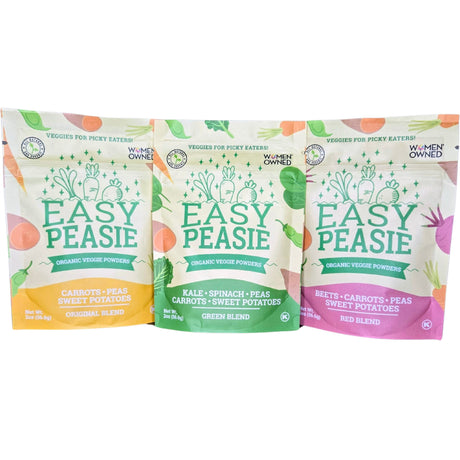Understanding Growth Spurts: A Parent's Guide
Growth spurts are those mysterious periods when children seemingly shoot up overnight, leaving their parents both amused and puzzled. We'll break down the concept of growth spurts, explaining the science behind these rapid growth phases.
Why Understanding Growth Spurts Matters
Parents and caregivers, fasten your seatbelts because understanding growth spurts is crucial for several reasons. We'll explore why being aware of these growth phenomena can make a significant difference in how you support your child's development.
Navigating Growth Spurts Together
In this blog, we'll equip parents and caregivers with the knowledge and strategies they need to guide their children through growth spurts. Get ready for practical insights and expert advice on this incredible journey.
What Are Growth Spurts? Unlocking the Mystery
Growth spurts are those transformative periods when children experience rapid physical growth and development, often in a relatively short time frame. These phases can sometimes catch parents off guard, leaving them wondering what's going on with their little ones.
Definition and Explanation of Growth Spurts

In simple terms, a growth spurt is like a burst of growth that occurs during a child's developmental journey. During these periods, kids may grow noticeably taller, gain weight, or experience other physical changes. But what causes these remarkable transformations? That's where the science of growth spurts comes into play.
The Science Behind Growth Spurts
Behind every growth spurt is a symphony of biological processes. Growth hormone, produced by the pituitary gland, plays a leading role. It triggers the growth of bones and tissues, resulting in increased height and size. During sleep, when the body is at rest, growth hormone secretion is at its peak, contributing to overnight growth.
When Do Growth Spurts Typically Occur in Childhood?
While every child is unique, growth spurts often follow a relatively predictable pattern. They tend to occur during infancy, around 6-8 weeks and 3-4 months old. Toddlerhood and early childhood also witness growth spurts, usually around 2 years old and again during the pre-puberty years, roughly between 8 to 14 years old.These periods of accelerated growth are exciting milestones in a child's life, and understanding when they are likely to happen can be incredibly helpful for parents and caregivers.
Signs and Symptoms: Navigating the Telltale Signs of Growth Spurts
As a parent or caregiver, it's crucial to be able to recognize the signs and symptoms of a growth spurt. These can vary from child to child, but here are some common indicators to watch out for.
Identifying Common Signs of a Growth Spurt
One of the most noticeable signs of a growth spurt is a sudden increase in appetite. Children may seem constantly hungry and request more frequent meals and snacks. Rest assured, this increased hunger is entirely normal and a positive sign of growth.
How Growth Spurts May Affect a Child's Behavior and Mood
Growth spurts can sometimes bring about changes in a child's behavior and mood. Some children become fussier or more irritable during this time, while others may experience sleep disturbances. These shifts can be attributed to the physical discomfort that can accompany rapid growth.
Physical Changes to Look for During a Growth Spurt

Physical changes are the hallmark of growth spurts. Parents might notice that their child's clothing suddenly seems too small, or their shoes no longer fit. Height gain is evident, and you may observe that your child's limbs appear longer. Additionally, children may gain weight as they grow taller, which is a normal and healthy part of development.
Factors Influencing Growth Spurts: Unveiling the Influences Behind Growth Acceleration
Understanding what drives growth spurts can help parents and caregivers support their children during these rapid periods of development.
Genetics and Family History
Genetics plays a significant role in determining a child's growth patterns. Children often follow a growth trajectory similar to that of their parents or other close family members. If you or your partner experienced notable growth spurts during childhood, it's possible that your child will too. However, genetics is just one piece of the puzzle, and environmental factors also play a substantial role.
Nutrition and Its Role in Growth
Nutrition is undeniably a vital factor in a child's growth. During growth spurts, children's bodies require additional nutrients to support their rapid development. Ensuring they have a balanced diet rich in essential vitamins, minerals, and protein is essential. Incorporating foods like lean proteins, dairy or dairy alternatives, fruits, vegetables, and whole grains can help provide the necessary nutrients for growth. If you have concerns about your child's nutrition during a growth spurt, consulting a healthcare professional or registered dietitian is a wise choice.
Sleep and Rest as Contributors to Healthy Growth
Quality sleep and adequate rest are crucial contributors to healthy growth. Growth hormone is predominantly released during deep sleep, making uninterrupted slumber essential for children. Encouraging a consistent sleep schedule and creating a comfortable sleep environment can aid in maximizing growth potential. During growth spurts, children may require more sleep than usual, so paying attention to their sleep cues is vital for their overall well-being.
Supporting Your Child Through Growth Spurts: Strategies for Nurturing Their Development
As a parent or caregiver, you can play a crucial role in helping your child navigate the challenges and opportunities that come with growth spurts.
Ensuring a Balanced Diet to Support Growth
Proper nutrition is the cornerstone of supporting your child's growth. During growth spurts, their bodies require additional nutrients to fuel the rapid development happening within. Ensure their diet includes a variety of foods rich in essential vitamins, minerals, and protein.
Incorporate lean meats, poultry, fish, legumes, dairy, fruits, vegetables, and whole grains into their meals. It's also a good idea to consult with a registered dietitian if you have any concerns about your child's nutrition during this time.
Creating a Healthy Sleep Routine

Quality sleep is indispensable for healthy growth. Establishing a consistent sleep routine is key to ensuring your child gets the rest they need. Ensure they have a comfortable and calming bedtime routine that promotes relaxation.
Limit screen time before bed, provide a cozy sleep environment, and maintain a regular sleep schedule. Keep in mind that during growth spurts, children may require more sleep than usual, so be attentive to their sleep cues.
Addressing Emotional and Psychological Needs During Growth Spurts
Growth spurts can be physically demanding and emotionally challenging for children. They may experience mood swings, frustration, or discomfort as their bodies rapidly change. It's essential to provide emotional support and understanding during this time.
Encourage open communication, validate their feelings, and offer reassurance. Engage in activities that help them cope with stress, such as mindfulness exercises, hobbies, or simply spending quality time together. By addressing their emotional and psychological needs, you can help them navigate this period of growth with confidence and resilience.
Clothing and Footwear: Dressing Your Growing Child Comfortably and Affordably
As your child experiences growth spurts, their clothing and footwear needs can change rapidly. Ensuring they have comfortable and well-fitting attire is essential for their physical and emotional well-being.
The Importance of Proper-Fitting Clothing and Shoes During Growth Spurts
During growth spurts, children's bodies undergo significant changes. Ill-fitting clothing and shoes can lead to discomfort, restricted movement, and even potential health issues. It's crucial to regularly assess their wardrobe to ensure items like pants, shirts, and shoes still fit appropriately.
Pay attention to signs of discomfort or clothing that appears too small, such as tight sleeves or pants that have become too short. Investing in well-fitting clothing and shoes can prevent physical discomfort and help your child feel confident and at ease during this transitional period.
Tips for Managing Wardrobe Changes Affordably
As your child outgrows their clothing and shoes, it's natural to seek budget-friendly ways to keep them comfortably dressed. Consider these strategies for managing wardrobe changes without breaking the bank:
- Hand-Me-Downs and Thrifting: Check if you have access to hand-me-downs from older siblings or relatives. Thrift stores and consignment shops are also excellent places to find gently used clothing and shoes at a fraction of the cost of new items.
- Sales and Discounts: Keep an eye out for sales, discounts, and clearance events at local stores and online retailers. Stocking up on basics during these promotions can save you money.
- Seasonal Shopping: Plan your shopping trips around seasonal changes. Buy clothing for the upcoming season during end-of-season sales when prices are reduced.
- Clothing Swaps: Organize clothing swaps with friends or within your community. This allows you to exchange outgrown items for ones that fit your child without spending money.
- DIY Alterations: If you're handy with a sewing machine, consider altering clothing yourself to make them last a bit longer. Simple adjustments like letting out hems or adding elastic to waistbands can provide extra wear.
By following these tips, you can ensure your child has a wardrobe that accommodates their growth comfortably while being mindful of your budget.
Healthcare and Regular Check-ups: Partnering with Professionals for Healthy Growth
Regular healthcare check-ups play a crucial role in ensuring your child's growth and development are on track. Here's how healthcare providers can support you and your child during growth spurts.
The Role of Healthcare Providers in Monitoring Growth
Pediatricians and healthcare providers are essential partners in monitoring your child's growth. They use growth charts and measurements to track your child's height, weight, and other key indicators. Regular check-ups help healthcare professionals identify potential growth issues early, allowing for timely interventions if needed.
By working closely with your child's healthcare provider, you can ensure that any concerns related to growth spurts are addressed promptly.
When to Seek Medical Advice During a Growth Spurt
While growth spurts are a normal part of childhood, there are instances where seeking medical advice is warranted. If you notice any of the following signs or symptoms during a growth spurt, it's advisable to consult with your child's healthcare provider:
- Extreme Pain: If your child experiences severe, unexplained pain or discomfort during a growth spurt, it's essential to consult a healthcare professional.
- Sudden Changes: If your child's growth spurt seems unusually rapid or accompanied by unexpected changes in behavior, appetite, or physical health, consult with a healthcare provider.
- Concerns About Growth Delay: If you have concerns about your child's growth, such as delayed development or stunted growth, seek medical guidance. Early intervention can be crucial in such cases.
Vaccinations and Growth Spurts
Vaccinations are an essential component of a child's healthcare routine, and they continue to be important during growth spurts. Healthcare providers can advise on the appropriate vaccination schedule to ensure your child is protected against preventable diseases.
It's important to discuss any concerns or questions you may have about vaccinations with your child's healthcare provider to make informed decisions about their health and well-being.
By maintaining regular check-ups and open communication with healthcare providers, you can ensure that your child's growth is monitored effectively, and any health-related concerns are addressed promptly.
Coping with Challenges: Supporting Your Child Through Growth Spurts
While growth spurts are a natural part of childhood, they can bring some challenges for both children and parents. Here's how to address potential issues and provide essential support.
Addressing Potential Challenges, Such as Discomfort and Growing Pains
It's common for children to experience physical discomfort during growth spurts, which may include growing pains. These pains are usually felt in the legs and can be described as achy or throbbing. To help your child cope with discomfort:
- Gentle Massage: Massaging the affected area with gentle strokes can provide relief.
- Warm Baths: A warm bath before bedtime can relax muscles and reduce discomfort.
- Pain Relief: Over-the-counter pain relievers, when approved by a healthcare provider, can be used sparingly if the pain is severe.
Strategies for Parents and Caregivers to Ease Discomfort
As a parent or caregiver, you can take several steps to ease your child's discomfort during growth spurts:
- Comfortable Bedding: Ensure your child's mattress and bedding are comfortable and supportive.
- Proper Hydration: Staying well-hydrated can help reduce muscle cramps and discomfort
- Balanced Diet: Provide a diet rich in calcium and magnesium, as these minerals are important for muscle and bone health.
Emotional Support During Times of Rapid Growth

Growth spurts can sometimes be accompanied by emotional changes in children. They may feel more sensitive, irritable, or tired. It's important to provide emotional support and understanding during these times:
- Open Communication: Encourage your child to express their feelings and concerns. Be a patient listener and offer reassurance.
- Rest and Relaxation: Ensure your child gets adequate rest and relaxation to help manage mood swings and irritability.
- Positive Reinforcement: Celebrate your child's growth milestones and achievements to boost their self-esteem and confidence.
By addressing physical discomfort, providing emotional support, and offering a nurturing environment, you can help your child navigate the challenges that may arise during growth spurts with greater ease.
Growth Spurts and Academic Performance: Strategies for Success
While growth spurts are a normal part of childhood, they can sometimes affect a child's academic performance due to physical and emotional changes. Here's how to help your child maintain focus and productivity in school during these periods.
How Growth Spurts May Impact a Child's Academic Performance
Growth spurts can bring about various physical and emotional changes that may influence academic performance:
- Fatigue: Rapid growth can lead to increased fatigue, making it challenging for a child to stay alert and engaged in school.
- Discomfort: Growing pains or physical discomfort can distract children from their studies and reduce their ability to concentrate.
- Emotional Changes: Mood swings or heightened emotions can affect a child's ability to manage stress and maintain focus.
Strategies for Maintaining Focus and Productivity in School
To support your child's academic success during growth spurts, consider these strategies:
- Healthy Sleep Routine: Ensure your child gets adequate sleep, as proper rest is essential for concentration and cognitive function.
- Balanced Diet: Provide nutrient-rich foods that support both physical and cognitive development. Omega-3 fatty acids, found in fish and flaxseed, are particularly beneficial for brain health.
- Regular Breaks: Encourage short breaks during study sessions to prevent mental fatigue. Physical activity during breaks can help alleviate discomfort.
- Effective Time Management: Help your child learn time management skills to prioritize tasks and reduce stress.
- Emotional Support: Offer emotional support and understanding during times of increased sensitivity. Encourage open communication about any challenges they may face in school.
- Teacher Communication: Keep teachers informed about your child's growth spurts so they can provide additional support or understanding if needed.
By implementing these strategies, you can help your child navigate growth spurts with minimal disruption to their academic progress, ensuring a smooth transition through this natural phase of development.
Navigating Growth Spurts with Care and Confidence
In this comprehensive guide, we've explored the phenomenon of growth spurts in children and learned how to navigate this transformative phase with knowledge and empathy.
Recap of Key Points about Understanding Growth Spurs
We defined growth spurts and delved into the science behind them, understanding when they typically occur in a child's life.Recognizing the signs and symptoms of growth spurts, both physical and emotional, can help parents and caregivers provide better support.Various factors, such as genetics, nutrition, and sleep, can influence the intensity and duration of growth spurts.
We discussed the importance of maintaining a balanced diet, fostering healthy sleep routines, and addressing emotional needs during these periods. Proper-fitting clothing and shoes, as well as regular check-ups with healthcare providers, are crucial aspects of caring for a growing child.
The Importance of Providing Proper Support and Care
Supporting a child through growth spurts involves more than just physical changes; it requires emotional and psychological support too.Being attuned to your child's needs, addressing potential discomfort, and ensuring they get enough rest are essential aspects of care.Effective communication with teachers and healthcare providers can make the transition through growth spurts smoother.
Encouragement for Parents and Caregivers
Embrace your child's growth journey with patience and understanding. Growth spurts are a sign of healthy development.Celebrate the milestones and changes, both big and small, that accompany each growth spurt.
Remember that providing love, support, and guidance during these phases can foster a strong parent-child relationship and set a positive foundation for future growth. As parents and caregivers, you play a vital role in helping your child navigate the challenges and joys of growth spurts. With knowledge and care, you can ensure that these phases are not only tolerable but also opportunities for growth and bonding.













